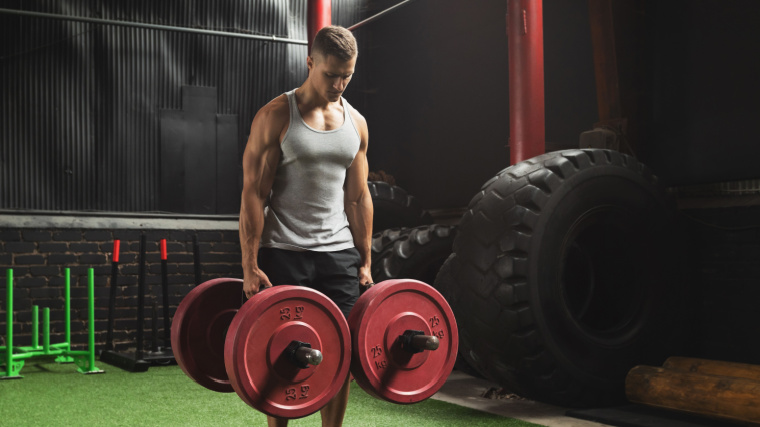Every joint plays an important role in your ability to make gains. Healthy joints help keep you in the safest positions possible with free weights while providing the most muscle-building potential. As you stretch and contract through a full range of motion, your muscles do the most work possible — which is exactly what healthily mobile joints enable.
In an age of technology, typing, and convenience, there’s a good chance that you start to feel some movement restrictions in your wrists. Much like tight calves or ankles, there can be a handful of reasons for this troublesome tightness.

Here are the eight best wrist mobility exercises to stay loose and start addressing potential root causes.
Best Wrist Mobility Exercises
- Wrist Extension Stretch
- Wrist Flexion Stretch
- Biceps Stretch
- Lat Stretch
- Wrist Curl
- Wrist Extension
- Wrist Figure-8
- Finger Opener
1. Wrist Extension Stretch
Stretching is one of the most common ways to address tightness or immobility. For something like wrist mobility, it is extremely accessible and easy to implement.
Stretching can help to relieve any acute aches and pains while also giving you a better idea of how stiff or immobile your wrists might be. From there, you’ll be able to gauge how to progress your wrist mobility routine. With a simple wrist extension stretch, you’ll highlight — and start addressing — any forearm issues.
How to Do it:
- Extend your arm straight ahead of your body and rotate your palm to face up.
- Using your free hand, lightly push your fingers toward the floor on the arm you are stretching.
- Press your fingers down until you feel a slight stretch across your wrist and forearm. Hold this stretch for several seconds or until you feel the muscle begin to relax.
Coach’s Tip: Try this same stretch by placing the working side palm against a wall instead of using your free hand.
Sets and Reps: For the best results, try to accumulate a total of 30 seconds to two minutes of stretching time on both sides. Shoot for a minimum duration of 15 seconds per stretch.
2. Wrist Flexion Stretch
It’s important to address both sides of your forearm if you’re aiming to improve your wrist mobility. Two of the major movements your wrist is able to perform are flexion and extension, so being on top of both is key.
Depending on your lifestyle, training, or work requirements, wrist flexion may be a bit tricky. This simple stretch helps get the ball moving, relieving any stiffness or immobility you feel on the top side of your forearm and restricting your wrist.
How to Do it:
- Extend your arm straight ahead of your body and rotate your palm to face down.
- Using your free hand, lightly begin to push your fingers toward the floor on the arm you are stretching.
- Press your fingers down until you feel a slight stretch across your wrist and forearm. Hold this stretch for several seconds or until you feel the muscle begin to relax.
Coach’s Tip: Try this same stretch by placing the working side palm against the surface you are sitting on instead of using your free hand.
Sets and Reps: Hold each stretch for at least 15 seconds at a time. Aim for an accumulation of a total of 30 seconds to two minutes of stretching time on both sides.
3. Biceps Stretch
The biceps may seem like you’re looking a bit further away from the wrist than expected, but they are a big contributor to your wrist mobility. Since your wrist is largely controlled by your forearms, the upper arm may impact how much your forearm freely moves as well.
If your biceps start getting tight from training, you might see your resting arm posture start to change. When this happens, the influence shows up in many biceps exercises such as barbell curls or shoulder exercises like overhead pressing. Particularly for barbell exercises, checking in on your biceps is a great way to avoid wrist issues.
How to Do it:
- Extend your arm straight ahead of your body.
- Place your palm against a wall as flat as possible.
- Extend your arm and slowly rotate your torso away from the outstretched arm until you feel a light stretch across your forearm and biceps.
Coach’s Tip: Move very slowly with the biceps stretch — you likely won’t need much to really start to feel it. As you rotate, be cautious not to overstretch.
Sets and Reps: Similar to other stretching protocols, accumulating a total time is your goal. Aim for at least 30 seconds to 2 minutes of stretch per side broken into at least 15 seconds at a time.
4. Lat Stretch
Moving one more link up the chain, the lats are a major player in controlling your shoulders, and therefore, your arms. Similar to how the biceps influence arm position and impact your wrist mobility, the lats are potentially even more significant here.
The lats internally rotate your shoulders when they are tight. This means your entire arm may subtly start to rotate to face the back of the room instead of a more neutral position. As with tight biceps, when this happens, it places your wrist in a compromising position during certain exercises.
How to Do it:
- Grab a dowel and low-to-medium plyo box.
- Drop down to a kneeling position and place your elbows on the edge of the box.
- While holding the dowel, maintain an underhand grip with your shoulders as square as possible.
- Keep a tight core brace with your ribcage and hip stacked, and slowly start to lower your torso to face the floor. Hold this position for a timed stretch.
Coach’s Tip: Focus on maintaining your core positioning and a neutral spine. This ensures your lats are the main focus of the stretch.
Sets and Reps: You’re able to stretch both lats simultaneously with this option. Aim for a total stretch time of 30 seconds to two minutes in durations of at least 15 seconds per stretch.
5. Wrist Curl
Strengthening your wrists is the other side of the mobility equation. Generating a hard contraction on either side of your forearm helps produce reciprocal inhibition (muscle relaxation) on the opposing side. When this happens, the working side can get stronger while the opposite side is released.
Having a strong set of forearm muscles also helps with overall stability and muscle balance. Your forearms pull your wrist through the ranges of motion they should be able to achieve, so adding strength here is a good choice to address your mobility.
How to Do it:
- Grab a set of dumbbells or an EZ curl bar.
- Set up by holding the weights comfortably in each hand with your arms hanging at your sides or slightly in front of your body. Alternatively, use a bench to support your wrist.
- Allow the weight to extend into your palm as you open your hand. Curl the weight using your fingers and forearms until you have fully flexed your wrist.
Coach’s Tip: Using tempo training — moving slowly — and implementing pauses are great tools for quality control. Avoid using momentum here.
Sets and Reps: Perform two to three sets of eight to 12 repetitions with about two minutes of rest between sets for the best results.
6. Wrist Extension
Similar to your wrist stretches, you don’t want to imbalance anything by neglecting both sides of your forearms. Wrist extensions help to keep building muscle evenly on either side of your forearm and maintain a strong, mobile set of wrists.
Similar to curls, wrist extensions increase strength and muscle on the working side while also encouraging relaxation on the opposite side. It’s a great idea to pair both flexion and extension for the best results.
How to Do it:
- Grab a pair of dumbbells or an EZ curl bar.
- Kneel down and use a weight bench to support your forearms, keep your palms facing down.
- Squeeze the weight tight throughout the range of motion, extending your wrists as much as possible.
- Lower the weight under control to return to the starting position. Perform for repetitions.
Coach’s Tip: Squeeze your hands as hard as possible throughout your wrist extension exercise. You cannot lift the weight if it slips out of your grip!
Sets and Reps: Perform two to three sets of eight to 12 repetitions with around two minutes of rest between each set.
7. Wrist Figure-8
Flexion and extension isn’t the only thing your wrists should be able to perform. Your wrists also move side to side (although much less than flexing and extending). Combining the two creates a fantastic easy-to-execute forearm dynamic warm-up exercise.
Wrist figure-8s help you check in on your wrists from all angles. They simultaneously help to warm up the area and give you great feedback on whether or not you’re tight. Pocket them anywhere you want, either as part of your dynamic warm-up or just throughout the day.
How to Do it:
- Place your palms together and interlock your fingers.
- Squeeze your hands and begin to rotate in a circular motion at the wrists.
- Perform these circle motions in both directions, swapping at least once before finishing your set.
Coach’s Tip: Be intentional with your wrist figure 8’s. It’s easy to go on autopilot and miss out on the range of motion. Be present and really stretch and extend into a full range of motion throughout your set.
Sets and Reps: Aim for 10-12 repetitions per direction or perform them continuously for about 15 seconds per direction.
8. Finger Opener
The fingers are another target to help improve wrist mobility. While the forearms are the major muscle group that affects your wrists, the fingers themselves may be overlooked. The muscles of the fingers also cross your wrist and can contribute to the tightness you may experience.
One of the most neglected movements in all of exercise is finger opening. Every time you grab a weight, your fingers must flex to hold onto the implement. However, how often are you performing the opposite? Finger extensions are a piece of the puzzle that helps restore balance to your wrist equation.
How to Do it:
- Grab a light elastic band and wrap it around your fingertips. Alternatively, perform finger openers with just your hand.
- Start in a “pinched” position, with your fingertips scrunched together.
- Open your fingers by fanning out your hand.
- Slowly return your fingers to the starting position and perform for repetitions.
Coach’s Tip: Adding tempo here is a great way to increase workout intensity without having to scour for ever tighter elastics. It also helps prevent elastic slipping!
Sets and Reps: Aim for two to three sets of 10 to 12 repetitions with approximately two minutes of rest. Alternatively, perform them for endurance, aiming for two to three sets of 15 to 20 repetitions and 30 seconds of rest.
Wrist Mobility Warm-Up
A warm-up is a crucial part of any workout and has a huge impact on smaller muscles that don’t get direct focus that often. Your wrist mobility warm-up should be lighter or more controlled versions of the main exercise to come — often with pauses or tempo to really target the right area. This helps you refine your technique before you load each exercise.
- Wrist Curl: One set of 12-15 repetitions. Pause in the fully contracted position.
- Wrist Extensions: One set of 12-15 repetitions. Use a controlled two-second eccentric portion.
- Finger Openers: One set of 15 repetitions with just your hand. Fully extend and squeeze for two seconds per repetition.
How to Train Your Wrist Mobility
Wrist mobility training is something you’re able to employ in almost any place or time throughout your day. This includes your workout, but also downtime at the office or at home. Just be mindful of how much or how hard you train your wrist mobility, however, as it can overlap with grip strength training.
Wrist Mobility Exercise Selection
Given your options for wrist mobility, it’s easy to separate stretching and strengthening exercises to best suit your lifestyle. Stretching exercises are easy to perform anywhere, with next to no real setup or equipment required.

Dmytro Zinkevych / Shutterstock
[Read More: The 8 Best Lifting Straps You Can Buy]
Weave strengthening exercises into your normal workout times, being mindful of where you place them within your workout. Finishing your day with them is a great way to leave the rest of your workout unaffected by your grip fatigue.
Wrist Mobility Sets and Reps
You’ll be splitting your wrist mobility training between stretches and weights here. For either option, select hypertrophy sets and repetitions, load, or duration of time based on your needs and goals.
- For Strength: To strengthen your wrist muscles, perform two to three sets of 8-10 repetitions with two to three minutes of rest.
- For Muscle Growth: To help build muscle, perform two to three sets of eight to 15 repetitions with two minutes of rest.
- For Endurance: To build some durability, perform three to four sets of 12 to 20 repetitions with 30 seconds of rest.
With any wrist mobility training goal, you have a range of repetitions to aim for. When it comes to strength, err on the “lighter side” before building up to repetitions lower than eight per set. Since your performance is influenced by your grip strength, give yourself time to build that up alongside your wrist mobility before shifting to heavier loads.
Wrist Mobility Training Tips
Wrist mobility is an often overlooked prong of a complete training program. To get the most out of your own wrist mobility drill, train your antagonist muscles, account for other training fatigue, and remember to take proper rest times.
Train Your Antagonists
Muscles are separated into agonists and antagonists during each exercise. The agonist is the muscle that is performing the work, whereas the antagonist is the muscle that is on the opposite side of the working muscle. Your forearm flexor muscles are antagonists to your forearm extensor muscles.
[Read More: The 18 Best Pre-Workouts, RDN-Approved (Personally Tested)]
It’s easy to get caught up in training one side and not necessarily the other. In this instance, you’ll be losing out on muscle strength and balance, but also some nifty reciprocal inhibition (or muscle relaxation). As your agonist contacts, the antagonist muscle relaxes to allow that to happen. For the best impact on your wrist mobility, always train both sides — hit your agonists and their antagonists.
Account for Training
A good workout program covers all the bases for your goals and ideally keeps you in tip-top shape generally. One rock that is often left unturned is your wrist mobility. But before you jump headlong into a super-focused wrist routine, consider the rest of your training.

[Read More: How to Close-Grip Bench Press to Build Your Triceps and Push Serious Weight]
Many of your best wrist mobility exercises also include training your hands and grip. Depending on the intensity and goal of your other training sessions, you may find that wrist mobility training negatively impacts them. Take a look at your entire program, and weave in wrist mobility training as seamlessly as possible, preferably after bigger grip-oriented moves like the farmer’s carry.
Take Proper Rest Periods
A notoriously common training error is not allowing for proper rest. From heavy back squats to wrist curls, adequate rest allows you to perform at your best on subsequent sets. This in turn maximizes your results.
[Read More: The Snatch-Grip Deadlift Is an Underrated Strength-Building Exercise]
Even for seemingly “small” muscle groups such as your wrist mobility muscles, the right amount of rest is crucial. Take the same amount of time to recover between wrist mobility sets as you would for a hard exercise anywhere else on your body. At least one to three minutes is appropriate depending on your goal.
Benefits of Training Your Wrist Mobility
While often neglected, training your wrist mobility has some pretty substantial benefits for your training overall. You may well experience better exercise execution, improved grip strength, and relief from nagging muscle tightness.
Better Exercise Execution
Upper body exercises are going to be rooted in your hands. From all your favorite triceps exercises to the bench press, your hands are in contact with your training tool at all times. This means that your wrist mobility and grip durability inherently impact performance.

[Read More: How to Do the Close-Grip Pulldown — Variations, Benefits, and More]
Better wrist mobility means that you’re more likely to perform each exercise and repetition through a proper range of motion. With thrusters, clean & jerks, and other grueling moves, ensuring a full range of motion helps deliver results much more efficiently. Don’t leave gains on the table — mobilize your wrists to stay diligent with your exercise execution.
Better Grip
Most upper-body workouts rely on your hands to perform at the highest level. With that in mind, so do your wrist mobility exercises. Pumping in some solid wrist mobility routines also reinforces your grip from a brand new training angle.
[Read More: The 10 Best Grip Strengtheners On the Market]
You can’t contract a big muscle if there’s nothing to contract against. Keep your grip tight and hang onto every barbell, cable, and kettlebell without fail. Given your wrist mobility exercise menu, you’ll see some great grip strength benefits along the way.
Tightness Relief
The most obvious benefit of wrist mobility training is the release of tight muscles. The main goal here from the start is to restore your ability to move freely through the wrists, and tight muscles get in the way. Stretch, strengthen, and mobilize yourself to a more relaxed set of wrists.

[Read More: The Complete Guide to Pre-Workout Supplements]
Stretching helps improve flexibility and acutely relax the muscle itself. Strengthening exercises ensure your ability to “pull” yourself through a full range of motion and also contribute to your mobility through reciprocal inhibition. This double whammy of contraction and relaxation is the key to massively improving wrist mobility.
What Muscles Make Up the Wrist
Your wrist mobility is going to be influenced by a few key muscles. The forearms themselves are the big ticket targets, both from the flexion and extension side of things. One lesser focused area is also your fingers. They have smaller muscles but they also influence wrist mobility and tightness.
- Forearm Flexors: Your forearm flexors are found on the front side of your forearms and make up muscles that flex your wrist, hand, and forearm itself.
- Forearm Extensors: Your forearm extensors are a group of muscles found on the backside of your forearm that extend the wrist, fingers, and forearms.
- Fingers: There are small and distinct finger muscles that cross your wrist in order to flex and extend each digit.
More Training Content
Training your wrist mobility has a number of great benefits across nearly all training goals. Reduced stiffness and improved flexibility may come to mind first, but you’ll also likely experience better exercise execution and grip strength as well.
Between that and the ability to seamlessly weave it into both your lifestyle and current training, there’s not really a downside. Try these eight best wrist mobility exercises and discover gains you didn’t even realize were yours to have.
- The Five Best Mobility Workouts for Staying Strong and Flexible
- 5-Minute Mobility: This Stretching Routine Is Perfect When You’re Low On Time
- Forge an Iron Grip With the 17 Best Forearm Exercises
Featured Image: Mangkorn Danggura / Shutterstock
The post The 8 Best Wrist Mobility Exercises to Help You Lift Heavier Barbells appeared first on BarBend.
